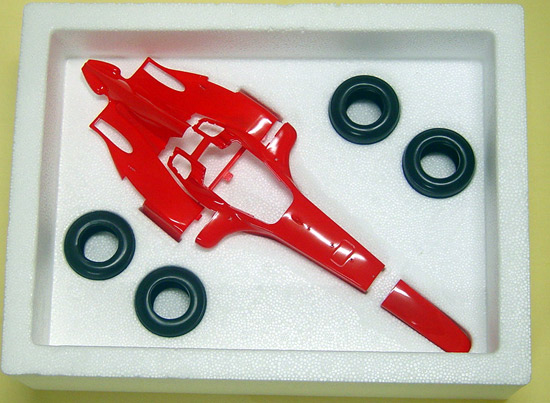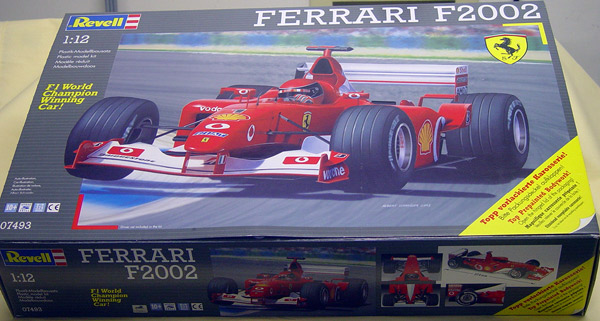|
Ferrari F2002

Revell Germany
S
u m m a r y
|
| Catalogue Number
and Description: |
07439 |
| Scale: |
1/12 |
| Price: |
100 Euro |
| Contents and Media |
Injection molded plastic, rubber
tires, metal screws and steering shaft, and plastic wire |
| Review Type: |
FirstLook |
| Advantages: |
Cheaper than the MG Models mixed
media kit |
| Disadvantages: |
Simplified detail for large scale,
incorrect wheels and harness. Quality of prepainted parts varies. |
| Recommendation: |
See below |

HyperScale is proudly supported by Squadron.com
Reviewed by Dave
Williams
One of the most successful Formula One cars in history, the
F2002 won 15 of the 17 races of the 2002 racing season. The domination of the
F2002 and the duo of Michael Schumacher and Reubens Barrichello allowed Ferrari
to amass as many Constructorsí points (221) as the sum total of all the other
teams combined. In addition, the performance of the vehicle was strong enough
that the F2002 was used for the first four races of the 2003 Championship
Season. The career of the F2002 ended on a high note with a win for Schumacher
for the 2003 San Marino Grand Prix at Imola.
Although modern F1 cars still tend to be popular with mainstream model
manufacturers, most appear to be produced in 1/20 or smaller scales. While the
newer Tamiya F1 kits are quite excellent, there remains a demand for seeing
current vehicles produced in the potentially more impressive 1/12 scale. Tamiya
previously did a number of F1 cars in 1/12 scale, however they were 1980ís era
and earlier cars, and Tamiya seems to have abandoned making new car kits in the
large scale. With Tamiya out of the picture, Revell Germany has answered the
call of Ferrari fans and released the championship-winning F2002 in injection
molded form.
One of the first things that one notes about the kits is the large size of the
box (something to consider if ordering from overseas). The box is considerably
larger than the box for my Tamiya 1/12 scale Lotus 78 J.P.S. Mk. III kit.
Opening the box, the reason for the size is apparent as one half of the box
space is occupied by a styrofoam tray that contains the four rubber tires and
the main body parts (nose, monocoque, and engine cover). This tray is presented
for viewing under the boxís flip up cover and the remaining part sprues are
packed conventionally in the remaining box space.

The next notable item is that the appropriate parts are prepainted in Ferrari
red. Combined with other parts molded in white plastic, black plastic, or
chromed in a satin finish, little painting is necessary is one wants to just
slap this kit together out of the box. The prepainting on the main body parts is
fairly decent with a few dust specks and some paint buildup along the part
edges, issues that can be easily corrected by rubbing down the finish. The
painted parts on the sprue are more of a mixed bag with items like the front
wing endplates showing a fair degree of orange peel in my sample. The undertray
is painted in both red and black with the demarcation line between the colors
being somewhat rough in places. Also, areas like the underside of the engine
cover remain unpainted, which may need to be addressed if one chooses to display
the car with the cover off. The jury is still out on whether prepainting the
parts is a good idea, however it is likely that those willing to pay the high
price for this kit may desire a better finish than what you get in the box. This
means extra time must be spent stripping off the paint that Revell worked to put
on in the first place. Fortunately, it appears that the underlying plastic is
white, which is good news for those repainting the red color. Moving on to the
other sprues, the satin chrome finish seems a little thin and my kit had some of
the chrome rubbed away by the surrounding plastic bag. Again, more repair work
for the serious modeler.
Click the
thumbnails below to view larger images:
Overall, the detail and quality of the parts is a little
disappointing for this large size, being somewhat less than recent 1/20 scale
Tamiya kits like the Williams FW24 and the Ferrari 2001, IMHO. The engine
detail, what there is, seems a little soft and the engine bay is missing most of
the various electronics boxes and associated wiring which is noticeable in this
scale. The only wiring included is the ignition wires that run above each
cylinder head. The cockpit detail is somewhat light with the various small knobs
on the steering wheel being represented only by decals instead of being molded
in 3-D as in the smaller Tamiya kits. Speaking of the cockpit, the kit contains
a harness that is molded in a soft flexible so that it can draped in the seat,
however the harness release and the buckles are simplified and rather
unconvincing. Some of the sprues have a significant amount of flash, which is
surprising in a new kit, however there is little flash on the actual parts.
However, there are some noticeable mold seams on some of the chromed exhaust
piping and seams still visible on the red painted parts. Again, this provides
more rationale for the modeler repainting the parts as eliminating the seams
will damage the finish.
The kit features a number of working features. The wheels turn and the front
wheels steer. A metal shaft is provided to link the steering wheel to the
steering bar so the steering wheel turns as the front wheels are moved
side-to-side. The fuel filler flaps on both sides are operable and the brakes
are designed so that the discs correctly rotate with the wheels while the
calipers remain stationary.
The decals are the highlight of the kit, being printed by Cartograf in Italy.
Markings are provided for the Magny-Cours race where Schumacher clinched the
World Championship that year. As France outlaws tobacco advertising at sporting
events, no Marlboro logs are provided. Car numbers and names are provided for
both drivers, although the kit does not model the slight differences in car
configuration between Reubensí and Michaelís cars. In addition to the bodywork
decals, a second decal sheet is provided which contains carbon fiber decals for
the suspension parts.
Accuracy seems generally good (i.e. it looks like a Ferrari F2002), however
there are a couple of notable errors. Firstly, the wheels are the ten spoke BBS
wheels fitted to the F2001 car. The F2002 car used wheels with only seven
spokes. Replacement wheels are about the only way to fix this error. In
addition, the harness is only a four-point harness (shoulder and lap). For a
number of years, the standard F1 harness has been a six-point harness with two
crotch straps.
If the car is to be built as it was raced at Magny-Cours, there are some other
issues that may need to be addressed for accuracy by the truly nitpicky.
Refueling at the French Grand Prix is performed from the left side of the car.
Unfortunately, the insert with the fuel connector is designed to only fit under
the right filler flap. The easy fix is to glue the filler flaps shut. In
addition, the kit features a nose camera on the right side of the nose. Photos
from the French Grand Prix show that neither car ran with this configuration
during the race. During the race, Michael had a nose camera on the left side and
Reubens has a rearward facing camera in a long fairing in front of the cockpit.
Finally, the bodywork fairing around the exhaust outlet pipe was cut back for
the race at about a 45-degree forward angle and both cars featured a small air
scoop in the oval panel on top of the nose. The previous items are not meant to
be criticisms of the kits, but addition guidance for those who use the kit
decals and want to make the car more representative of how it appeared in the
race.
I have mixed feeling on providing a recommendation for this kit. There are some
errors and quality issues that some people may feel that should not be on a kit
that costs approximately 100 Euros. On the other hand, others might really want
a large scale modern F1 car that isnít a super expensive multimedia kit and be
willing to work through issues with Revell kit. It all depends on each
individualís viewpoint and the best defense against being surprised is in
knowing what you are going to get.
Sample kit courtesy of my ever dwindling bank account.
Dave Williams
IPMS/USA 19050
Review Copyright © 2003 by Dave
Williams
Page Created 10 November, 2003
Last updated 10 November, 2003
Back to HyperScale
Main Page
Back to Reviews
Page
|
Home | What's
New | Features
| Gallery |
Reviews | Reference
| Forum
| Search